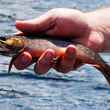My wife was pulling overnight Grandma-duty and, left to my own devices for dinner, my thoughts turned toward bratwurst. I’d found a five-pack of the Johnsonville brand in the freezer a couple days earlier and they’d been calling my name in an oom-pah German accent ever since. I usually buy the brats made in-house at Sal’s, my neighborhood grocery store, where the sign out front frequently advertises “OUR BRATS—$2.99.” So how or why I’d come to purchase the pre-packaged Johnsonville variety was, like so much in life, a bit of a mystery.
One of the great things about living in Wisconsin is that, unless you’re way off the grid, chances are that you’re pretty close, or at least close enough, to a grocery store, butcher shop, or meat market that makes fresh bratwurst. And even if you’re not, any C-store or mini-mart, no matter how remote its location, is likely to carry at least one of the popular national brands, such as Johnsonville or Klement’s. These products are excellent, by the way, so other than the warm fuzzy feeling you get from buying local and supporting the traditions of artisanal sausage-making, it’s not a “compromise” to go that route.
Hard-core bratmeisters may howl, but in the 40-plus years that I’ve lived in Wisconsin—the smoking, sizzling, mustard-spattered, sauerkraut-draped, beer-drenched heart of American bratwurst culture—my experience has been that the differences between one brat and the next tend to be pretty trifling. Certainly every maker has his own recipe, and every maker has its partisans. There’s Usinger’s in Milwaukee, Miesfeld’s in Sheboygan, Nolechek’s in Thorpe, the Lodi Sausage Company, the list goes on, and on, and on. Still, the basic ingredients—fatty cuts of coarsely ground pork seasoned with salt, pepper, and a mix of spices that may or may not include coriander, marjoram, ginger, sage, allspice, nutmeg, mace, caraway seed, and ground mustard seed—are largely the same, yielding a flavor/texture profile that falls within recognizably familiar limits.
I’m talking about the classic uncured fresh brat here, of course, not the smoked version (acceptable, just different) or any of the abominable “flavored” varieties. What matters most is how you cook them, the ideal in this respect being a process that can be summed up in five words: low and slow over charcoal.
While a gas grill can yield satisfactory results, that hit of headily fragrant flavor you get from pork fat vaporized by live coals is lost. And, regardless of what you may have been told or taught, parboiling brats prior to grilling is just plain wrong. At best it’s unnecessary; at worst it messes up the protein reactions that make a good brat “snap” when you bite into it and then, after the briefest moment of resistance, explode with salty, spicy, unctuously juicy goodness when it hits your tongue. Yeah, that’s what I’m talkin’ about.
What is acceptable, if you’re cooking for a crowd, is to take the finished brats off the grill, transfer them to a pot into which you’ve dumped several cans of whatever beer you’re drinking (ideally something in the lager-pilsener group), a couple of sliced onions, and a stick or two of butter, and keep the whole shebang at the lowest simmer you can manage until it’s serving time. Some in the brat camp view this step as indispensable, their feeling being that the beer-onion-butter bath amps up the flavor and juiciness; my take is that a perfectly browned brat hot of the grill is unimprovable, and that the bath is simply the best way to keep them at the proper temperature without drying them out. Shrinkage, as all men know, is the enemy; it’s no accident that a long-ago Esquire piece on the proper way to cook bratwurst was titled “A Triumphant Wiener.”
The bath thing does tend to impress the guests, though (Man, this guy really knows what he’s doing! ); plus, it gives you the option of using the simmered onions as a condiment.
Once the coals were ready—I used lump charcoal started in a chimney—I spread them in the bottom of my Weber Kettle and set the grill grate on its flanges (or whatever the hell they’re called). Then I scraped the grate with a wire brush, ran a paper towel soaked in canola oil over it for good measure, and put the lid on. After fiddling with the vents in order to keep the fire from getting too hot, I cracked a Red Stripe and waited for the temperature to stabilize at around 375°. My Weber’s the model with a built-in thermometer—a damn handy feature.
Someone described the ideal method for grilling brats as “the two-beer technique,” meaning that your brats should be done in the time it takes to drink two beers. This assumes a normal rate of consumption, which roughly translates to 15-to-20 minutes. (Remember, we’re talking Wisconsin here.) This is more-or-less the way I try to do it, starting the brats on the outer edges of the grill, turning them often as they begin to brown (a sturdy set of tongs is important), and gradually moving them towards the hotter portion of the fire.
You shouldn’t get too fussy about it, though, because the other imperative here is to keep the cover on as much as possible, both to maintain heat and to maximize the brats’ smoke exposure. That’s another fine line you learn to walk: While you want some of that fatty juice hitting the coals—that’s what produces that wonderful smoke, after all—you want it coming out in drips, not geysers. A brat doing an Old Faithful impression is a brat being cooked at too high a temperature, and thus in imminent danger of drying out—the cardinal sin of the backyard bratmeister. It’s for this same reason that you don’t want your brats splitting their skins, either.
It all comes back to heat management and those two little words: low and slow.
I was still working on my second Red Stripe but I judged my brats to be done: crackly skinned and charred to a deep mahogany brown, with a few pinpricks of juice bubbling out. Perfect! I had a standard-issue brat bun, basically a beefed-up hot dog bun, at the ready; unlike a lot of consumers, I prefer my buns soft, i.e., untoasted. (In Sheboygan, where all bratwurst makers, cooks, and eaters from other parts of the world are viewed as wannabes, the only acceptable platform is a disk-shaped, locally baked specialty with a crusty top known as a Sheboygan hard roll.)

I had my condiments ready, too: chopped raw onion, crispy sauerkraut (the kind you find in the refrigerator section), spicy mustard. There was a time when I would have added a little pickle relish, but now I take my pickles, in whatever form—for this meal I’d made a batch of bracingly astringent cucumber-and-dill salad—on the side. The ketchup was where it’s supposed to be when brats are on the menu: in the refrigerator. As certain friends whose tastes are stuck in adolescence have heard me say ad nauseum, you don’t put ketchup on sausage. This dictum applies to hot dogs as well, in my opinion, although a majority of Americans apparently disagree with me about that.
I shook some potato chips onto my plate—original Ruffles, in case you’re wondering—and the presentation was complete. Sitting down at the patio table, happy to be able to eat outside again, I took the brat in both hands, tilted my head to it, and took a bite. It was everything I’d dreamed it would be. There was the crisply smoky skin, the burst of salty juice, the meaty richness of the seasoned pork, the mingled tangs of the condiments, the unifying generosity of the pillowy bun.
I took a sip of Red Stripe and thought, Life is good.
































Comments
David Clegg replied on Permalink
As a graduate of UW - Madison and having numerous fraternity brothers from Sheboygan I can attest to the legitimacy of the author’s perspectives on how best to prepare the ultimate brat. There is no question that par boiling in advance of grilling is a sin of the highest nature! My preference is to enjoy a brat bun and to leave the Sheboygan hard role to those that hail from that part of the State. Regardless, brats and beer represent the essence of Wisconsin and reading this article will encourage me to head out to my nearest Door County grocery so I may enjoy the grilling and eating experience this weekend! On Wisconsin!!
John Donelson replied on Permalink
Yum..... Just cooked an assortment of specialty sausages last night on a baby weber.. Fantastic. Would only change one thing.... Get rid of the wire brush. GF works in OR and her small community hospital get 2 or 3 add on cases a MONTH where they have to take a patient to the OR to remove one of the wire bristles from a patients throat
....Just a thought...
Hexmeister replied on Permalink
That's why I always follow up the wire brush with an oil-soaked paper towel. It's not as if you need to oil the grates to keep bratwurst from sticking!
Mike Rosborough replied on Permalink
Red Stripe? Cheeseheads drink Spotted Cow!
Christopher Badgley replied on Permalink
As a graduate of UW-Stevens Point I agree with the author on all but one item. Red Stripe beer? Are you kidding me? I like Red Stripe with the appropriate jerk chicken and ackee, but Red Stripe with brats? Never! Give me a cold Point beer, or three, and add some boiled corn to the mix…
Hexmeister replied on Permalink
OMG, Point is ABSOLUTELY the primo beer to drink with brats. But Red Stripe is what I had.....
Philip Ross replied on Permalink
Can't believe they allowed you to post something about grilling. That has to be hard on the environment. Not Green at all. But, grilled brats are great no matter where you are. Haven't figured out how to cook on the river with electric or solar.
Pages